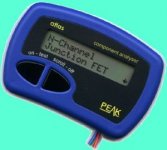Folks, Happy New Year
Iam in the process of assembling a P3a amp. The layout on the PCB suggest that the transistor pins are arranged (looking in the front of device from left to right) as collector , base and emitter. I checked this a number of times to make sure.... hope iam correct. However, the datasheet for BC546 (philips) suggest that the transistor pins as emitter , base and collector for the TO-92 package. Iam a bit confused on the transistor placement.Is the transistor to be placed by turning it around? thanks in advance
Iam in the process of assembling a P3a amp. The layout on the PCB suggest that the transistor pins are arranged (looking in the front of device from left to right) as collector , base and emitter. I checked this a number of times to make sure.... hope iam correct. However, the datasheet for BC546 (philips) suggest that the transistor pins as emitter , base and collector for the TO-92 package. Iam a bit confused on the transistor placement.Is the transistor to be placed by turning it around? thanks in advance
sam9
It is quite possible. The NTE cross reference guide cautions on this. Appearentlt the leads are not consistent between manufacturers for some TO-92 types. Having stumbled on to this in the context of PCB layout software, I always double check the lead configuration of the device vs. the PCB pattern.
It is quite possible. The NTE cross reference guide cautions on this. Appearentlt the leads are not consistent between manufacturers for some TO-92 types. Having stumbled on to this in the context of PCB layout software, I always double check the lead configuration of the device vs. the PCB pattern.
BC546
Looking at an old Cricklewood catalog that I have, that usually served me to identify transistors, if you lie down the transistor, with flat face up and pins toward you, what you have is:
collector-base-emitter
From left to right.
Don't you have a multimeter to test that? In any case it should be better for you to match input tansistors for same Beta.
Carlos
Looking at an old Cricklewood catalog that I have, that usually served me to identify transistors, if you lie down the transistor, with flat face up and pins toward you, what you have is:
collector-base-emitter
From left to right.
Don't you have a multimeter to test that? In any case it should be better for you to match input tansistors for same Beta.
Carlos
Use the data sheet for the transistors you have and match up the correct pins. They may or may not match the board. Good luck.
Both the PCB and the data sheet are correct. The data sheet shows the pins from the BOTTOM of the device rather than the top. Once you look at it from this perspective, it all makes sense. Confusing? You bet!
I am referencing the following: http://www-us.semiconductors.philips.com/acrobat/datasheets/BC546_547_3.pdf
I only realized this after I installed all my transistors backwards because I incorrectly assumed the diagram in the data sheet was a top view.
I am referencing the following: http://www-us.semiconductors.philips.com/acrobat/datasheets/BC546_547_3.pdf
I only realized this after I installed all my transistors backwards because I incorrectly assumed the diagram in the data sheet was a top view.
One thing worth mentioning is that a circuit can possibly work even if C and E of some or all transistors are swapped.
I had this problem several times - why do two amplifiers built on the same PCB, wired with the same cable, housed in the same chassis sound and perform so different? Took me days to figure out 🙂
I don't know a way of finding out whether pinout is E B C or C B E with a multimeter... B C E would be easy, but...
I had this problem several times - why do two amplifiers built on the same PCB, wired with the same cable, housed in the same chassis sound and perform so different? Took me days to figure out 🙂
I don't know a way of finding out whether pinout is E B C or C B E with a multimeter... B C E would be easy, but...
Component analyzer
Hi! Check out this...
http://www.peakelec.co.uk/atlas.htm
I have found this tool helpful...and a great help when you do not find the datasheet.
Arne K
NORWAY
Hi! Check out this...
http://www.peakelec.co.uk/atlas.htm
I have found this tool helpful...and a great help when you do not find the datasheet.
Arne K
NORWAY
Attachments
I am yet to come across a BC546 in TO92 pack with a different pinout, from any manufacturer. As pointed out earlier, both the PCB layout and the data sheet are indeed correct. The data sheet shows the bottom view of the transistor with the flat side of the package facing you.
- Status
- Not open for further replies.
- Home
- Amplifiers
- Solid State
- P3A amp - BC546 Placement
